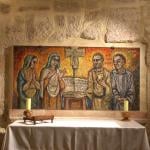On any showing, Romans 10.4 is a crucial verse for understanding Paul’s thought world. The discussion on p. 1172 deserves a close look. Tom takes the verse is a rather narratological way– namely that Christ is the goal, the final destination of Torah, by which he means “This is where the narrative had been heading all along. Through the Messiah the prophecies have come true, the covenant has been re-established, exile is over, God himself has acted to unveil his faithfulness to his promises and God’s people are now able…to keep Torah from the heart.” (p. 1172, bottom). This rendering he prefers to the notion that Christ is the end of the Mosaic Law. But of course the text doesn’t just say ‘Christ is the goal/end of Torah’. The subject here is ‘the righteousness of God’ which as we saw in the last post, doesn’t mean the renewal of the covenant. What 10.3-4 says literally is ‘for not knowing the of God righteousness, and seeking to establish their own [righteousness], the righteousness of God they did not submit to. For Christ is the ‘telos’ of the Law unto righteousness for all those believing.” The subject then is a means or way of righteousness, not the end of a narrative flow. Christ is the end of Torah, the Mosaic Law as a means of righteousness for those who believe (implied– ‘in Him’). The text goes on to contrast two forms of righteousness– the kind that comes from Torah keeping, and the kind that comes from faith in Christ. While of course it is true that Paul thinks Christ is the fulfillment or goal of the Biblical story line, that is not in view here.
Further problems arise when we get to the exposition of Rom. 10.10 on p. 1175— which Tom wants to translate “Because the way of covenant membership is by believing with the heart, and the way of salvation is by professing with the mouth.” Again it will be useful to offer a literal rendering— “for you believe in the heart unto righteousness, and you confess with your mouth unto salvation”. Notice the parallel construction between righteousness and salvation. Neither of these phrases are about covenant renewal they are about the means of being set right, the means of being saved, which has to do with genuine heart-felt belief and confession. In other words, this is about Paul’s soteriology and Christology in the main.
Tom’s comment on p. 1175 that Paul is not inaugurating a two ways approach to salvation here (which he calls a two covenants approach) is on target. For Jew and Gentile alike there is one means of salvation believe in and confession of Christ. Paul is crystal clear about that here and elsewhere. But in another sense, Paul is most definitely inaugurating a two covenant schema here— The Mosaic covenant has been brought to an end in Christ, and the new covenant has been inaugurated, not as a renewal of the circumcision covenant, but as a fulfillment of the promises of the Abrahamic one.
The discussion moves on, on p. 1176, to Rom. 9.30-33 and 10.18-31, which in Tom’s chiastic schema are seen as in parallelism. Tom stresses that the main point of these passages is that Israel (as a whole; Paul will point out at 11.1-6 that he and others like him constitute the righteous remnant of Israel) has strangely failed to arrive where they hoped, and that Gentiles, surprisingly, have found themselves arriving there instead. Tom insists again that righteousness means membership in God’s people. Now this is a strange reading here because ‘Israel’ was certainly not striving to ‘arrive at membership in God’s people’ they were already there by God’s choice! No they were striving to arrive at righteousness, a different matter frankly. What the Gentiles were getting was ‘saved’, set right with God, sanctified, and so on. And this indeed is what Israel needed as well. Tom takes Paul to be saying ‘Israel was hunting for the law of righteousness, but did not attain to the Law’ as opposed to the normal reading ‘Israel hunting for righteousness did not attain righteousness’. It will be well again to give a literal rendering of Rom. 9.30-32a because Paul is setting up a contrast here– “What then shall we say? That the nations, the ones not pursuing righteousness, attained righteousness, but a righteousness which comes from faith. But Israel, seeking the law of righteousness unto law did not attain it. Why was this? Because [they pursued it] not from faith but as from works”.
Notice once again that in this text as before in Rom. 9-10, Israel means Jews, period. It does not mean the church which includes Gentiles. Indeed the contrast between the Gentile nations and Israel could not be clearer here, and frankly that contrast is maintained throughout to the end of Rom. 11. Secondly we do not have a contrast between two ways of pursuing covenant membership but two ways of pursuing righteousness– by works of the Mosaic Law, or by faith in Christ. The second part of the comparison is somewhat difficult to unpack, but the essence of its seems to be that Paul is saying that Israel did not attain righteousness by pursuing it by means of works of the Law. It should be stressed that the latter is referring to a group that is in the covenant and pursuing righteousness thereafter, trying to please the God they have already cut the covenant with by means of works of the Law. It is not a reference to their seeking right standing with God in the first place, or covenant membership in the first place. In other words, the issue here is not ‘right-standing’ but indeed actual righteousness, and Paul is saying that through faith the believer is changed, becomes a new creature in Christ, yes is set right, but more than that is transformed into a new person. The attempt to become a new person, a changed person by keeping all 613 commandments of the Mosaic Law is an exercise in futility, not least because all have sinned and fallen. In short it is faith in the living Word, not keeping the written instructions of Moses, which changes a person.
By way of review, Tom is contending (see p. 1177) that the train of thought in Rom.9.30-10.13 is much the same as in Rom. 7.7-8.11, and especially 7.21-8.4. Tom suggests the real problem for Israel was their Adamic condition, the fault not being in the Law itself (p. 1178). This however is not quite the whole story. While the Law in itself was holy, just, and good, it was also impotent to change human nature, something only God’s Spirit could do. This is precisely why the emphasis in Rom. 8 is on the Spirit, and notice there are two Laws or principles contrasted there— the Law of sin and death, and the Law of the Spirit of life. I have suggested, and will suggest again, that nomos most certainly does not always mean ‘the Mosaic Law’ in Paul. Sometimes it means a ruling principle in general— so for example in Rom. 7 where we have the law of the mind contrasted with a ‘different law’ in one’s members. This is not two ways of talking about the same law, it is a reference to two different ruling principles. And here we touch on another problem with Tom’s analysis. Everytime the word ‘law’ comes up, he assumes it refers to the Mosaic Law, when not infrequently it does not, and it especially does not when Paul is talking about the Law of Christ in Galatians and 1 Corinthians. Galatians 6 tells us what the Law of Christ is: 1) some of teachings of Christ; 2) some of the OT teachings reaffirmed; 3) some of the apostolic teachings based in 1) and 2). This is not about a renewal of Mosaic Law or that covenant, it is about a lex nova for a new covenant. Period. The effect of the Mosaic Law on fallen person is death-dealing, not life-giving, though that was never the purpose or intent of the Mosaic Law. The effect of the Law of Christ, on redeemed persons is to given them instructs on how to live lives pleasing to God,because, enabled by the Spirit and God’s grace, they can do so! For instance, as 1 Cor. 10 says, they can avoid willful conscious sin.
p. 1179 suggests that Tom thinks the reference to the stone of stumbling at the end of Rom. 9 is multivalent– it refers to Torah yes, but also to Christ who is seen as the goal of Torah. He may be right about this, since elsewhere the stone of stumbling is identified with Christ in the NT, or it may be that only Christ is alluded to as the stone of stumbling here. After all Torah was laid not in Zion but in Sinai, and Christ’s death in Zion is the real stone of stumbling in Paul’s view (see 1 Cor.1-4).












